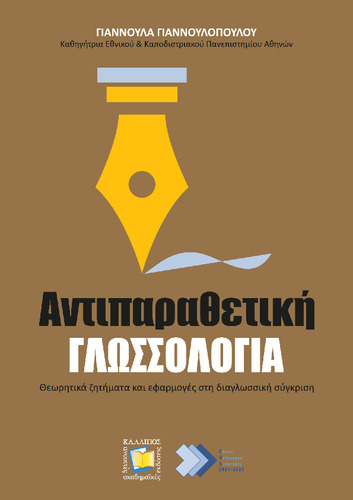| Title Details: | |
|
Contrastive linguistics |
|
| Other Titles: |
Theoretical issues and applications to language comparison |
| Authors: |
Giannoulopoulou, Giannoula |
| Subject: | HUMANITIES AND ARTS > LINGUISTICS HUMANITIES AND ARTS > LINGUISTICS > FIELDS OF LINGUISTICS > FIELDS RELATED TO THE STRUCTURE OF LANGUAGE > MORPHOLOGY HUMANITIES AND ARTS > LINGUISTICS > FIELDS OF LINGUISTICS > FIELDS RELATED TO THE MEANING OF LANGUAGE > SEMANTICS HUMANITIES AND ARTS > LINGUISTICS > FIELDS OF LINGUISTICS > DESCRIPTIVE LINGUISTICS > CONTRASTIVE LINGUISTICS |
| Keywords: |
Greek
Italian French German Contrastive linguistics Tertium comparationis Phonetics/Phonology Morphology Compounding Semantics Language Teaching Historical-comparative linguistics Language typology Generativist approaches Functionalist approaches Synchronic distribution Diachronic evolution Definite article |
| Description: | |
| Abstract: |
The book offers an introduction to the basic concepts and methods of Contrastive Linguistics (CL), a rapidly developing branch of theoretical and applied Linguistics. CL is one of the fields that deal with the comparison between languages. CL compares a small number of languages (usually two to four) from a synchronic point of view and independently of their genetic relationship.
The first part of the book introduces the basic concepts and the methodology of CL and presents the relationship between CL and both Historical – Comparative Linguistics and Language Typology. It also examines the differences between linguistic theories (generative and functionalist ones) about contrastive analysis and analyzes inter-linguistic comparison at every level of the language system (phonetics/phonology, morphology, syntax, semantics), as well as pragmatics.
The second part of the book focuses on a specific contrastive analysis of linguistic data in four languages (Greek, Italian, French, German). In particular, the phenomena discussed are a) the definite article, in which syntax, semantics, and morphology are involved, and b) compounding, a morphological process with semantic dimensions.
Although the point of view of contrastive analysis is mainly synchronic, it also includes the diachronic dimension to give a full interpretation. Each chapter includes exercises on both the theory and its applications.
|
| Linguistic Editors: |
Galanopoulos, Giannis |
| Graphic Editors: |
Papadatou, Chara |
| Type: |
Undergraduate textbook |
| Creation Date: | 02-05-2023 |
| Item Details: | |
| ISBN |
978-618-5726-93-5 |
| License: |
Attribution - NonCommercial - ShareAlike 4.0 International (CC BY-NC-SA 4.0) |
| DOI | http://dx.doi.org/10.57713/kallipos-222 |
| Handle | http://hdl.handle.net/11419/9378 |
| Bibliographic Reference: | Giannoulopoulou, G. (2023). Contrastive linguistics [Undergraduate textbook]. Kallipos, Open Academic Editions. https://dx.doi.org/10.57713/kallipos-222 |
| Language: |
Greek |
| Consists of: |
1. Introduction Basic concepts 2. Methodology and aims of contrastive linguistics 3. Historical issues on the development of contrastive linguistics 4. Relations between contrastive linguistics and historical-comparative linguistics 5. Relations between contrastive linguistics and language typology 6. Linguistic theories and contrastive linguistics 7. Summing up of the first part (chapters 1- 6) 8. The definite article in Greek, Italian, French, and German: synchronic distribution 9. The definite article in Greek, Italian, French, and German: diachronic development 10. Compounding in Greek, Italian, French, and German: morphological and semantic features 11. Compounding in Greek, Italian, French, and German: diachronic development 12. Summing up of the second part (chapters 8 - 11) |
| Number of pages |
326 |
| Publication Origin: |
Kallipos, Open Academic Editions |
| You can also view | |
| User comments | |
There are no published comments available! | |

